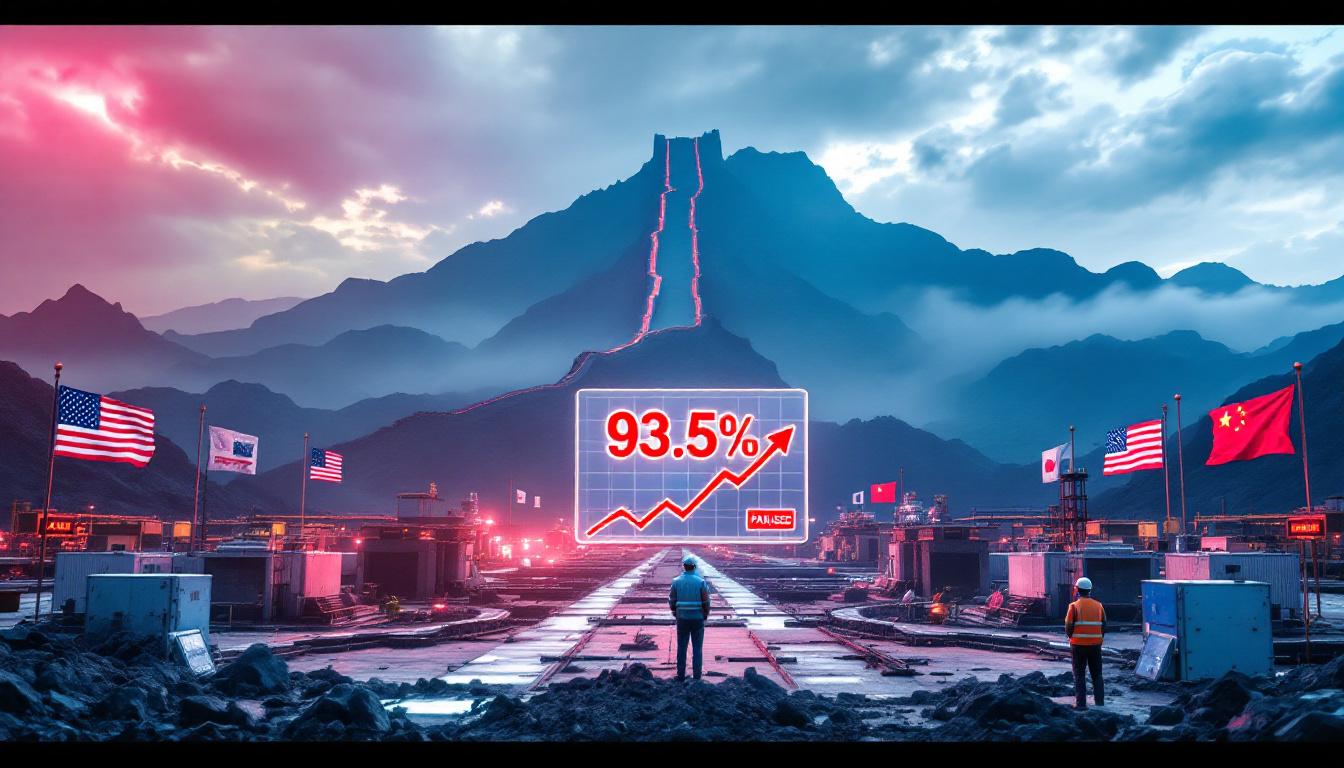Rio Tinto's CEO Succession: A Strategic Pivot Toward Unlocking Shareholder Value
Rio Tinto recently announced that CEO Jakob Stausholm will step down at the end of 2025, triggering a formal succession process with far-reaching strategic implications. This leadership transition arrives at a pivotal moment when investors are increasingly focused on unlocking the mining giant's underlying value potential amid broader mining industry evolution.
The announcement follows Rio Tinto's recent annual general meeting where shareholders rejected a formal proposal to review the company's dual-listed structure. Yet paradoxically, this same meeting intensified pressure on the board to address the substantial valuation gap between its London and Australian listings – a disconnect that has become increasingly difficult to ignore.
"This leadership transition represents an inflection point rather than a disruption, reinforcing a broader strategic shift already underway at Rio Tinto," noted JPMorgan analysts in their recent assessment of the situation.
The Leadership Contenders Shaping Rio Tinto's Future
Two internal candidates have emerged as frontrunners in the succession race, each bringing distinct expertise to the table:
Bold Baatar currently serves as Chief Commercial Officer and has been with Rio Tinto since 2013. His commercial acumen and experience negotiating complex international agreements – particularly his instrumental role in the Oyu Tolgoi copper mine expansion in Mongolia – position him as a strong contender.
Simon Trott heads Rio Tinto's iron ore division, the company's most critical business unit generating approximately 80% of group EBITDA. Under his leadership since 2021, the Pilbara operations have continued their digital transformation journey, with autonomous haul trucks reducing operational costs by approximately 15% while improving safety metrics.
Both executives bring deep operational knowledge of Rio's core businesses, with complementary skill sets that align with the company's dual priorities of operational excellence and strategic transformation.
The Valuation Gap: A $20 Billion Opportunity Hiding in Plain Sight
The persistent valuation discrepancy between Rio Tinto's dual listings represents one of the most compelling value creation opportunities in the global mining sector:
- Rio Tinto plc shares (London-listed) currently trade at approximately a 19% discount compared to their Australian counterparts
- This gap has fluctuated between 15-22% over the past five years but has remained stubbornly persistent
- Based on current market capitalizations, this discount represents approximately $20 billion in potential shareholder value
JPMorgan's detailed sum-of-parts analysis suggests up to 30% potential upside based on their valuation of Rio Tinto's individual assets, establishing a base case target of £59.20 per share – substantially above current trading levels.
This structural inefficiency bears striking similarities to the situation BHP faced before unifying its dual-listed structure in 2022, a move that successfully eliminated its valuation discount and simplified its corporate structure. The recent BHP's strategic pivot offers valuable lessons for Rio Tinto as it navigates its own transformation.
Strategic Pathways to Value Creation
The incoming CEO will face immediate pressure to implement structural changes aimed at unlocking shareholder value. Three primary strategic vectors have emerged:
Portfolio Optimization
Rio Tinto has already begun divesting non-core assets, generating $1.2 billion from sales in the first half of 2024 alone. Future optimization efforts will likely focus on:
- Accelerating the strategic review of underperforming divisions
- Potential separation of businesses that receive inadequate valuation within the current structure
- Greater capital allocation discipline toward tier-one assets with substantial growth potential
Corporate Structure Simplification
The dual-listed company structure, while historically serving specific purposes, has become increasingly difficult to justify given the persistent valuation discount:
- Options include consolidating to a single primary listing (likely Australian)
- Implementing more balanced capital allocation between the listings
- Creating mechanisms to reduce arbitrage opportunities between the two exchanges
Enhanced Capital Returns
Rio Tinto's strong balance sheet provides flexibility to increase shareholder returns while maintaining strategic investments:
- Current payout ratio of 60% could potentially increase
- Targeted share buybacks focusing on the more discounted London listing
- Establishment of clearer metrics for capital deployment decisions
Core Assets Driving Rio Tinto's Future Growth
Rio Tinto's strategic position is anchored by several world-class operations that provide both stability and growth potential:
Iron Ore Operations (Pilbara, Australia)
The Pilbara region remains the cornerstone of Rio's cash flow generation, producing 340 million tons of iron ore in 2023. These operations benefit from:
- Industry-leading automation and operational efficiency improvements
- Strategic port and rail infrastructure creating sustainable competitive advantages
- Relatively low carbon intensity compared to global competitors
With future performance heavily dependent on iron ore price forecast trends, Rio Tinto continues to focus on maintaining its cost leadership position in this critical market.
Expanding Copper Portfolio
As global electrification accelerates, Rio Tinto's copper assets have taken on increased strategic importance:
- Oyu Tolgoi (Mongolia): Recently completed underground expansion will increase production to approximately 500,000 tons annually by 2026
- Resolution Copper (United States): This development-stage project has the potential to supply 25% of US copper demand, though regulatory challenges remain
- Kennecott (Utah): Ongoing productivity improvements and expansion opportunities at this established operation
These copper assets position Rio Tinto to benefit from projected supply deficits, with industry analysts at BloombergNEF forecasting a potential 10 million ton global copper deficit by 2030 as electrification drives demand growth.
Analyst Perspectives: Value Opportunity Trumps Transition Uncertainty
JPMorgan's analysis frames the CEO succession as a catalyst rather than a concern:
- Maintained "overweight" rating on Rio Tinto stock
- Established base case valuation of £59.20 per share
- Identified Rio as their sole overweight recommendation among European, Middle Eastern and African diversified miners
While JPMorgan leads the bullish case, consensus among analysts has shifted toward cautious optimism. According to FactSet data, 16 of 26 covering analysts now rate Rio Tinto as either "buy" or "overweight," with an average price target implying 22% upside potential.
The primary concern cited by more cautious analysts centers on commodity price vulnerability rather than the leadership transition itself, with UBS and Morgan Stanley maintaining "neutral" ratings while acknowledging the potential for structural value creation.
The Transformation Timeline: When Might Shareholders See Results?
While the formal CEO transition won't occur until late 2025, strategic initiatives are likely to accelerate well before then:
- Near-term (3-6 months): Board response to shareholder pressure expected, potentially outlining structural review framework
- Medium-term (6-12 months): Groundwork for major strategic changes likely to begin
- Long-term (12-24 months): Implementation of structural simplification extending into 2026
This extended timeline aligns with historical precedents in the mining sector, where CEO transitions typically require 12-18 months for full strategy rollout and implementation. However, the clear shareholder mandate for change may accelerate this timeline compared to previous leadership transitions at Rio Tinto.
Recent industry consolidation trends suggest that Rio Tinto's strategic pivot will likely occur against a backdrop of broader restructuring across the global mining sector.
Intrinsic Value vs. Market Reality: Quantifying the Opportunity
JPMorgan's detailed sum-of-parts analysis reveals significant potential upside:
- Valuation range of £58 to £61 per share
- Material premium to current trading levels around £45
- Valuation supported by quality of underlying mining assets
This analysis takes into account Rio Tinto's diverse portfolio, with particular emphasis on:
| Asset Group | Valuation Contribution | Key Value Drivers |
|---|---|---|
| Iron Ore | 60-65% | Pilbara operations, automation benefits |
| Copper | 20-25% | Oyu Tolgoi expansion, Resolution potential |
| Aluminum | 10-12% | Vertical integration, low-carbon positioning |
| Other Minerals | 5-8% | Diamonds, titanium dioxide, lithium |
Independent valuation specialists at Refinitiv broadly align with this assessment, suggesting Rio Tinto's current discount to intrinsic value ranks among the largest in the global diversified mining sector.
The Shareholder Mandate: Demand for Bold Action
The market reaction to both the AGM vote and the CEO succession announcement reveals clear shareholder expectations:
- 42% of shareholders supported a formal review of the dual-listed structure at the AGM, a surprisingly strong showing for what was considered a long-shot proposal
- Activist fund Bluebell Capital's 2024 campaign for structural changes has gained traction with institutional investors
- Major shareholders have privately expressed support for more aggressive value creation initiatives
These shareholder priorities will likely shape the criteria used to select Stausholm's successor and define the strategic mandate for Rio Tinto's next chapter. The board's responsiveness to these concerns will be closely watched in the coming months.
Potential Roadblocks to Value Creation
While the opportunity is clear, several challenges could complicate Rio Tinto's value creation journey:
- Regulatory hurdles: Any structural reorganization would require approvals across multiple jurisdictions
- Tax implications: Simplified structure could trigger tax consequences requiring careful navigation
- Stakeholder management: Australian shareholders and government may resist changes perceived as diminishing local influence
- Commodity price volatility: Sharp declines in iron ore prices could limit financial flexibility
The board and incoming CEO will need to navigate these challenges while maintaining operational excellence across Rio Tinto's global portfolio.
The Investment Case: Why Rio Tinto's Leadership Transition Matters
For investors, Rio Tinto's current situation presents a compelling opportunity:
- Valuation discount: Shares trading well below sum-of-parts valuation
- Strategic catalyst: CEO transition creates momentum for structural change
- Shareholder pressure: Growing investor activism increases likelihood of value-unlocking actions
- Commodity exposure: Portfolio weighted toward materials essential for energy transition
While patience may be required given the extended timeline, the potential for 20-30% value creation through structural improvements provides a margin of safety beyond normal commodity price fluctuations.
According to recent investment opportunities insights, Rio Tinto's CEO succession represents one of the most significant potential value catalysts in the global mining sector for 2025.
FAQ: Rio Tinto Leadership Transition
Will Rio Tinto consider breaking up the company?
While a complete breakup seems unlikely, the company may evaluate strategic separations of certain assets or divisions to unlock shareholder value if the valuation discount persists. Precedents exist within the mining sector, such as Anglo American's 2023 consideration of spinning off its platinum and diamond businesses.
How might the dual-listing structure be simplified?
Options include consolidating to a single primary listing (likely Australian), implementing more balanced capital allocation between the listings, or creating mechanisms to reduce arbitrage opportunities. BHP's 2022 unification provides a recent blueprint, having successfully collapsed its dual-listed structure into a single Australian listing.
What impact might this have on Rio Tinto's dividend policy?
Any strategy focused on shareholder returns would likely maintain or enhance Rio Tinto's dividend policy, with the current payout ratio of 60% potentially increasing. This could be supplemented by increased share buybacks targeting the more discounted London listing to maximize value creation.
Could Rio Tinto become an acquisition target during this transition?
Rio Tinto's scale makes a complete acquisition unlikely, but the valuation discount could attract additional activist investors pushing for more dramatic structural changes. Partial acquisitions of specific assets might also be considered if they unlock greater value than the current consolidated structure.
How might this leadership change affect Rio Tinto's ESG commitments?
The new CEO will likely continue Rio Tinto's ESG transformation following past controversies. The company's 2025 net-zero target for Pilbara operations and broader decarbonization strategy are deeply embedded in strategic planning, as institutional investors increasingly demand strong environmental and social governance alongside financial performance.
As official statements from Rio Tinto confirm, the succession plan is designed to ensure continuity of the company's strategic direction while creating opportunities for structural enhancements.
Important Note: This analysis contains forward-looking statements and represents opinions based on currently available information. Actual outcomes may differ materially based on future developments, commodity price movements, and strategic decisions by Rio Tinto's board and management. Investors should conduct their own due diligence before making investment decisions.
Ready to Track Major Mineral Discoveries as They Happen?
Don't miss the next market-moving mineral discovery on the ASX. Discovery Alert's proprietary Discovery IQ model delivers instant alerts and actionable insights on significant discoveries, giving you a crucial market edge. Start your 30-day free trial today and position yourself ahead of the market.




